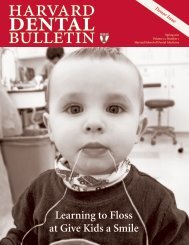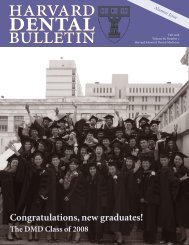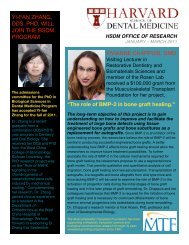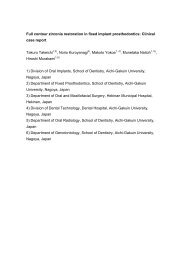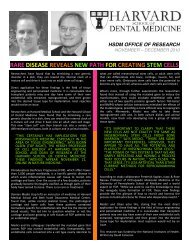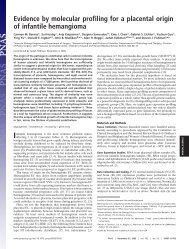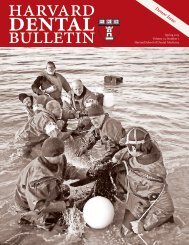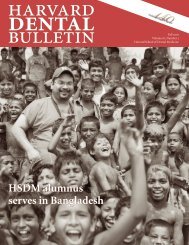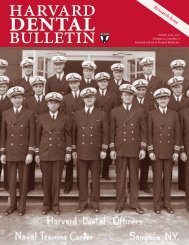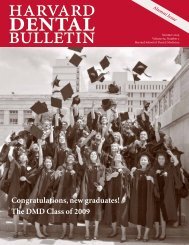Public Health Issue - Harvard School of Dental Medicine
Public Health Issue - Harvard School of Dental Medicine
Public Health Issue - Harvard School of Dental Medicine
- No tags were found...
You also want an ePaper? Increase the reach of your titles
YUMPU automatically turns print PDFs into web optimized ePapers that Google loves.
public health focusJan ReissElsbeth Kalenderian, right, chair andassociate pr<strong>of</strong>essor <strong>of</strong> oral healthpolicy and epidemiology at HSDM,poses at the EZCodes conferencewith Dr. David Clark, health scientistadministrator <strong>of</strong> the Behavioral andSocial Sciences Research Branch,Division <strong>of</strong> Extramural Research, atthe National Institute <strong>of</strong> <strong>Dental</strong> andCrani<strong>of</strong>acial Research. Kalenderian haspromoted use <strong>of</strong> the EZCodes at HSDMand other institutions nationwide.HSDM Receives NIH Patient Safety Research GrantAlthough clinical adverse events exact significant tolls on the health <strong>of</strong> individual patients and burden the nationwith massive, avoidable costs, currently little to no understanding exists about the type or frequency <strong>of</strong> patient safety issuesin dentistry. Dentists, like physicians, routinely perform highly technical procedures in complex environments, work inteams, and use a multitude <strong>of</strong> devices and tools, but the patient safety revolution has bypassed dentistry. Only the grossest<strong>of</strong> dental care adverse events have been documented.In order to reduce patient harm and improve the quality <strong>of</strong> care delivered, there is a critical need to define andidentify adverse events in dental settings. In the long term, it is important to understand the causes <strong>of</strong> dental adverse eventsand develop interventions to minimize their occurrence. Elsbeth Kalenderian, chair and associate pr<strong>of</strong>essor <strong>of</strong> oral healthpolicy and epidemiology, and colleagues recently received a grant from the National Institutes <strong>of</strong> <strong>Health</strong> to develop the toolsnecessary to document dental adverse events and generate a classification scheme and repository that can help organizeand link adverse events—both <strong>of</strong> which are entirely novel contributions to dental care and research. These steps will enablea new field <strong>of</strong> dental research that has broad and direct implications for patient safety, quality improvement, and healtheconomics. As part <strong>of</strong> the project, five dental organizations, which together see more than 100,000 patients per year, willbegin to systematically collect and analyze adverse events, thus creating a rich set <strong>of</strong> data to improve the quality <strong>of</strong> dentalcare. In addition, this project will greatly raise awareness <strong>of</strong> the importance <strong>of</strong> patient safety in dentistry.harvard dental bulletin • winter 2012–1313



